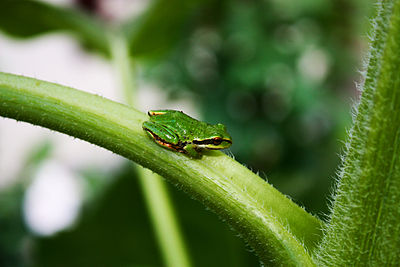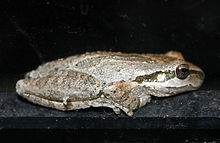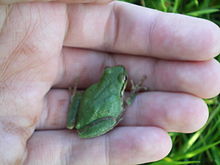- Pacific Tree Frog
-
Pacific Tree Frog 
Conservation status Scientific classification Kingdom: Animalia Phylum: Chordata Class: Amphibia Order: Anura Family: Hylidae Genus: Pseudacris Species: P. regilla Subspecies: see text Binomial name Pseudacris regilla
(Baird & Girard, 1852)Synonyms Hyla regilla
The Pacific Tree Frog (Pseudacris regilla) has a range from the West Coast of the United States (from Northern California, Oregon, and Washington) to British Columbia, in Canada. They live from sea level to more than 10,000 feet in many types of habitats, reproducing in aquatic settings. They are the only frogs that go "ribbit".[1] They come in shades of greens or browns and can change colors over periods of hours and weeks.
Contents
Sub Species
The Pacific tree frog has 3 sub species : the Northern pacific tree frog (Pseudacris regilla regilla), the Sierran tree frog (Pseudacris regilla sierra), and the Baja California tree frog (Pseudacris regilla hypochondria).
Anatomy and morphology
The Pacific Tree Frog grows up to 5 cm. from snout to urostyle. Males are usually smaller than females and have a dark patch on their throats. The dark patch is the vocal sac, which stretches out when the male is calling. Pacific tree frogs can be a number of different colors, including green, tan, reddish, gray, brown, cream, and black, but most are a shade of green or brown, with pale or white bellies. They have a variety of dark and spotty markings on their backs and sides and can be identified by a black or dark brown eye stripe that stretches from the nose, across the eye, and back to the shoulder. They can change color seasonally to better match their environment. Their skin is covered in small bumps. They have long legs compared to their bodies and they tend to be slender. Their toes are long and only very slightly webbed. On the end of each toe, there is a round sticky toe pad or disks used for climbing and sticking to surfaces.
Distribution, habitat and ecology
Pacific tree frogs are most common on the pacific coast of California, Oregon and Washington, but they are found anywhere from Baja California all the way up to British Columbia. They are also found eastward to Idaho, Montana, and Nevada. A small population also exists in a pond on Revillagigedo Island near Ketchikan, Alaska, having been intentionally introduced there in the 1960's.[2] They are found upland in ponds, streams, lakes and sometimes even further away from water: their habitat includes a wide variety of climate and vegetation from sea level to high altitudes. The Pacific tree frog makes its home in riparian habitat as well as woodlands, grassland, chaparral, pasture land, and even urban areas including back yard ponds. Eggs of the Pacific Tree Frog may be consumed by the Rough-skinned Newt[3] and other amphibians.
Reproduction, development and behavior
The Pacific Tree Frog begins mating in early winter to early spring. Since these frogs are so widespread geographically, it is thought that their breeding season is determined by local conditions. When it is time, the males migrate to the water. They then make a call at the same time, calling "kreck-ek" or ribbiting loudly. This lures the females to the water and they mate. The females lay their eggs in clumps of 10-90 and usually put them on and under vegetation and leaf litter in the pond. Females usually lay their eggs in shallow, calm water that has little action around it. If they survive, embryos will hatch into tadpoles within one to three weeks. The tadpoles feed on periphyton, filamentous algae, diatoms, and pollen in or on the surface of the water. They feed using a beak like structure that helps scrape vegetation off surfaces and suction.
Metamorphosis usually follows about 2 to 2½ months later, but experience raising these tadpoles shows that some may delay metamorphosis, changing up to 5 months after hatching. The survival rate of these delayed metamorphs is lower, and the evolutionary utility of this delayed metamorphosis is uncertain.
During the final stages of transformation when the tadpoles have 4 limbs and a tail, they stop feeding for a short time while their mouths widen and their digestive system adjusts from herbivorous to carnivorous. Then the frogs begln to emerge from the pond, sometimes measuring less than 1 centimetre.
For the most part, Pacific Tree Frogs are nocturnal, but they have been spotted during the day. These frogs spend a lot of time hiding under rotten logs, rocks, long grasses, and leaf litter, where they are very difficult to see unless they move. When they hunt, their toe pads allow them to climb on vegetation and other surfaces where they are to ambush their prey. Much of their diet consists of spiders, beetles, flies, ants, and other insects and arthropods; they can and do eat insects that are almost as large as they are, and will expand their bodies slightly to accommodate these meals.
Pacific Tree Frogs mature quickly, and will most likely be able to mate within the next season after metamorphosis. Predators include snakes, raccoons, herons, egrets, and other small mammals and reptiles.
When they sense potential food nearby, they will commonly twitch a toe to attract it within easy reach of their tongue.
Evolutionary history
The evolutionary history of these frogs is a very interesting one that is still being debated. Amphibians themselves are thought to have descended from the lobe-finned bony fishes. These fish had an ossified skeleton and emerged from the water as they developed limbs, girdles, and terrestrial characteristics such as lungs and a neck.
It is hard to figure out an exact frog lineage because of the lack of fossil record. The habitat in which these animals lived was moist and decay was quick. This was not helpful in preserving biological clues. The family of Hylidae is somewhat recent, appearing around 50 million years ago. The genus Hyla then appeared just after the dinosaurs went extinct. This genus originated in South America and expanded to the north into Mexico and eventually into North America. There was then a rise in sea level and the connection between the northern and southern populations was gone. They have been separate ever since, and have become genetically distinct from one another.
For this reason, the genus Hyla has been split into three separate genera: Aris, Limnaoedus, and Pseudacris. This is where the current confusion has taken place. Although the Pacific Tree Frog has carried the scientific name of Hyla regilla for many years, the most current consensus among scientists is that they should actually be Pseudacris regilla. This is still not agreed upon completely, and in the future we will see what becomes of these names.
Green and brown color morphs
One of the most interesting features of these frogs is their ability to change color from brown to green. Previously, it was thought that there were two different fixed colors that an adult tree frog could be. Now it has been found that some of them are able to change between the two. They can also change from lighter to darker, shift from patterned markings to pure colors and vice versa, and even display combinations of colors, brown/green being the most frequent.
These color changing morphs are triggered not by color change in their environment, but a change in background brightness. This type of environmental change would be caused by seasonal fluctuation. A full change in the dorsal coloration of a color morph can take anywhere from weeks to months, but initial changes can occur in just a few hours. This has been shown to be a very useful cryptic survival feature for these frogs.
Skin color is produced via pigment cells called chromatophores. There are commonly three types of chromatophores found in amphibians: 1. Xanthophores - These contain yellow, orange, or red pigments and are found uppermost on the dermis; 2. Iridophores - These lie below the xanthophores and function by reflecting and scattering white light up through them; in the case of Pseudacris regilla and many other North American frogs, iridophores reflect blue light through the yellow pigment cells above to create a green frog; 3. Melanophores - These are the deepest pigment cells and are responsible for the presence of black and brown pigments.
A rare, recessive "blue morph" is known. There was one housed at the Humboldt State University Natural History Museum in Arcata, California; however, this museum is now closed. See link. [2] It has been suggested that this mutation inhibits the xanthophores' ability to produce yellow pigments, thus the normally green frog (possibly of the non-color-changing type) appears blue.
Homing
Research was done on the Pacific Tree Frog to discover if they have homing instincts and what was their main source knowing where their home was. In order to find the answer, these frogs were marked and moved 300 yards away from their pond. Several days later, the researchers did a recapture on the original pond in which 66.3% of the frogs were recaptured indicating that there was some source of homing instinct. This was made apparent again when 24 frogs were placed into a larger pond and 20 of those frogs were returned at their original pond. The frogs’ movement patterns, olfactory, auditory, and kinesthetic senses could be explanations for the homing, but not a single factor was able to explain the results indicating that these frogs might be using all or a combination of these factors for homing.[4]
Conservation status
These frogs are the most common frogs on the west coast of North America. Although the Pacific Tree Frog remains abundant, some other species found in the same areas such as California red-legged frogs are declining. Most populations of tree frogs appear healthy, and they have no concern or conservation status.
Regional importance
In 2007, the Pacific Tree Frog was named the state frog of the State of Washington.[5] The Pacific Tree Frog is also a very important species in all of the regions where it is found because it is a keystone species. Many other species such as garter snakes depend upon its abundance as a prey item for their survival.
References
- ^ Nash, Pat (February 2005). "The RRRRRRRRiveting Life of Tree Frogs". http://www.beachwatchers.wsu.edu/island/essays/TreeFrogs.htm. Retrieved 8 January 2011.
- ^ Pacific Chorus Frog, Hedges 1986, da Silva. 1997, Reimchen 1990, Waters et al. 1996[1]
- ^ C. Michael Hogan (2008) Rough-skinned Newt (Taricha granulosa), Globaltwitcher, ed. Nicklas Stromberg
- ^ James, David L. 1957. Population structure and homing responses in the Pacific Tree Frog. American Society of Ichthyologist and Herpetologists. Copeia. Vol. 1957 No. 3 pp. 221–228
- ^ State Symbols
External links
- Fact sheet, taxonomic details, distribution maps, slideshow, and images of Pseudacris regilla at ZipcodeZoo.com.
- Californiaherps.com description - Includes detailed description, photos, recordings of calls
- mister-toad.com Pacific Tree Frog description - Description of the ecology of Pacific Tree Frogs with photographs, audio and video.
- http://www.npwrc.usgs.gov/resource/herps/amphibid/species/hylareg.htm
- Pacific Chorus Frog recordings
Categories:- IUCN Red List least concern species
- Hyla
- Animals that can change color
- Chorus frogs
Wikimedia Foundation. 2010.




